France
France’s contribution to data for development
Investing in having more and better data for sustainable development is becoming a greater priority for France’s development co-operation. France engages in statistical capacity building through the multilateral and bilateral channels with the objective to strengthen statistical production, data dissemination, and statistical literacy and to advocate and promote the use of data for better decision making. France supports developing countries’ national statistical systems through technical assistance and funding for equipment, but also through direct financing to national statistical offices.
France has started to look at the potential contribution of big data to development co-operation. For instance, the Agence Française de Développement supports the Open Algorithms (OPAL) Project through a EUR 1.5 million grant in 2017 for projects in Colombia and Senegal. This project aims to unleash the power of big data held by private companies for the public good. OPAL provides an open platform and algorithms that can be run on the servers of business partners to extract accurate, timely and reliable key development indicators that are relevant for a wide range of potential users, while at the same time preserving privacy at multiple levels: personal, group/community and commercial.
According to the 2017 Partner Report on Support to Statistics (PRESS) dataset, France committed on average USD 0.69 million per year to finance national statistical capacities and systems in developing countries in 2013-15.
Financial flows from France to developing countries
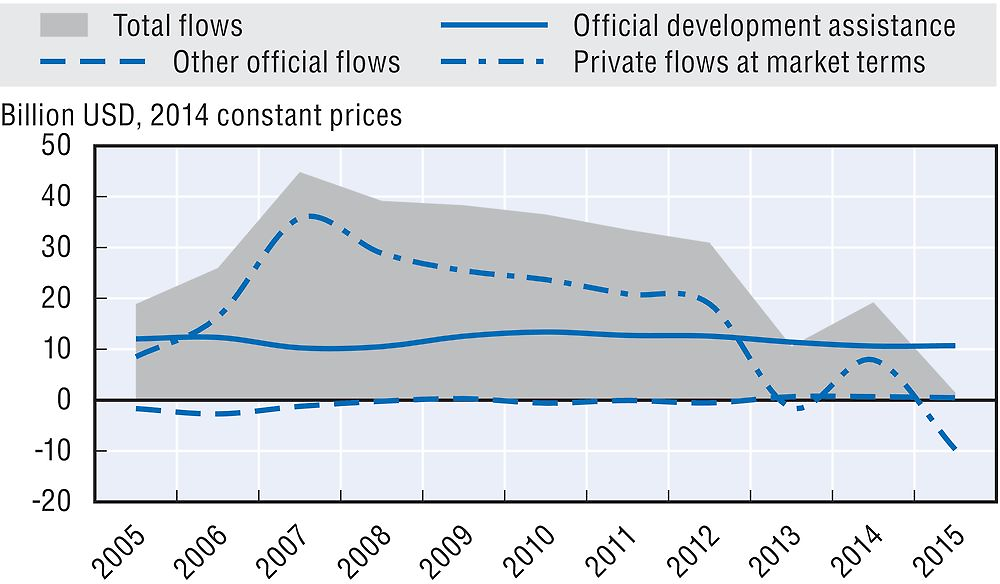
France’s use of ODA to mobilise other resources for sustainable development
-
USD 5.8 million of official development assistance (ODA) was committed to the mobilisation of domestic resources in developing countries, e.g. to support the development of their tax systems, in 2015.
-
USD 2.8 billion of ODA (+29.4% in real terms from 2014) was committed to promote aid for trade and improve developing countries’ trade performance and integration into the world economy in 2015.
France’s performance against commitments for effective development co-operation
France’s official development assistance
In 2016, France provided USD 9.5 billion in net ODA (preliminary data), which represented 0.38% of gross national income (GNI) and a 4.6% increase in real terms from 2015, due to an increase in bilateral lending. France is committed, at European level, to collectively achieve a 0.7% ODA/GNI ratio by 2030. France’s share of untied ODA (excluding administrative costs and in-donor refugee costs) was 95.6% in 2015 (increasing from 92.3% in 2014), compared to the DAC average of 78.1%. The grant element of total ODA was 79.6% in 2015, lower than in 2014 (when it stood at 85.6%) and below the DAC compliance grant element norm of 86%.
In 2016, in-donor refugee costs were USD 428 million, an increase of 17.2% in real terms over 2015, and represented 4.5% of France’s total net ODA.
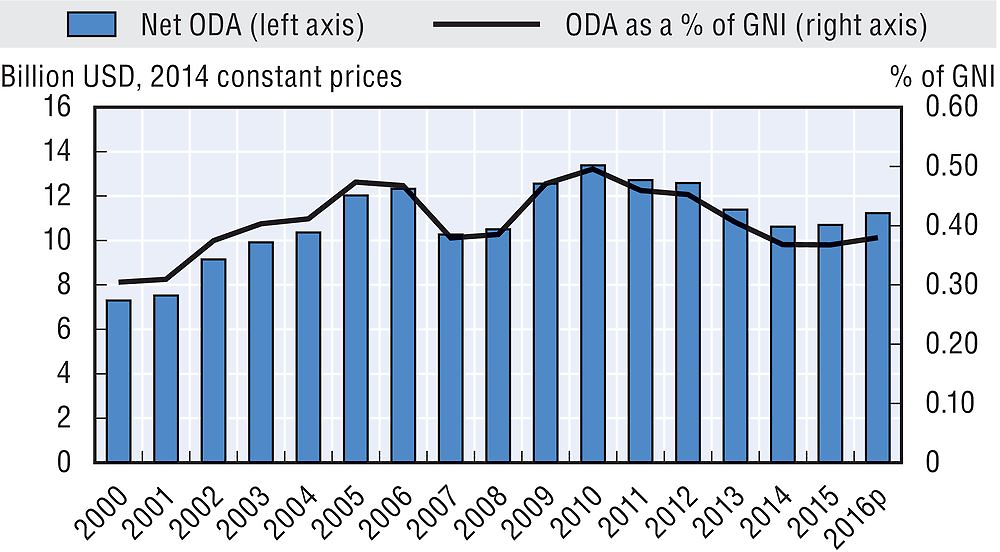
p: Preliminary data.
In 2015, 62.1% of ODA was provided bilaterally. France allocated 37.9% of total ODA as core contributions to multilateral organisations, compared with the DAC country average of 26.2%. In addition, it channelled 1.7% of its bilateral ODA for specific projects implemented by multilateral organisations (multi-bi/non-core).
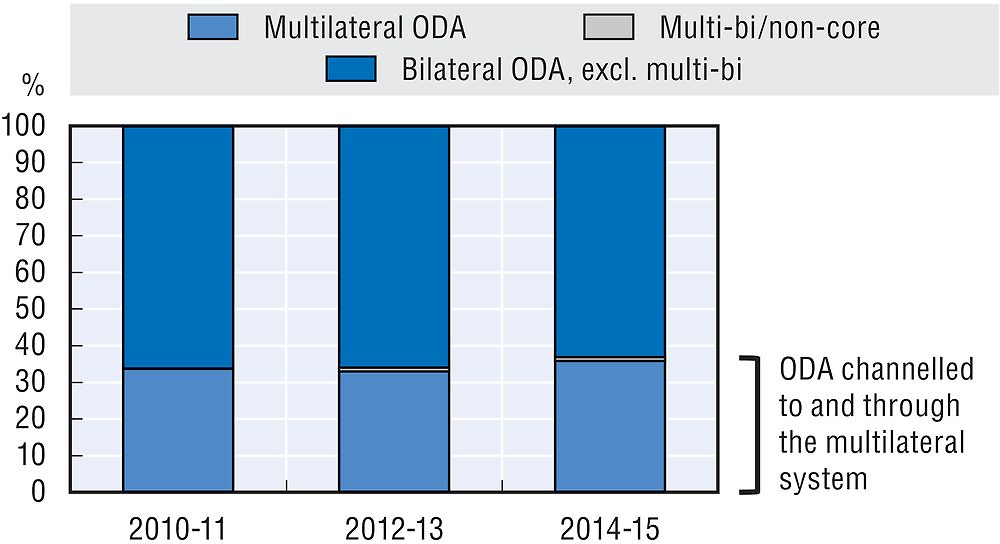
In 2015, 67.6% of French gross bilateral ODA was programmed with partner countries. France’s share of country programmable aid was higher than the DAC country average (48.8%) in 2015. Project-type interventions made up 80.9% of this aid.
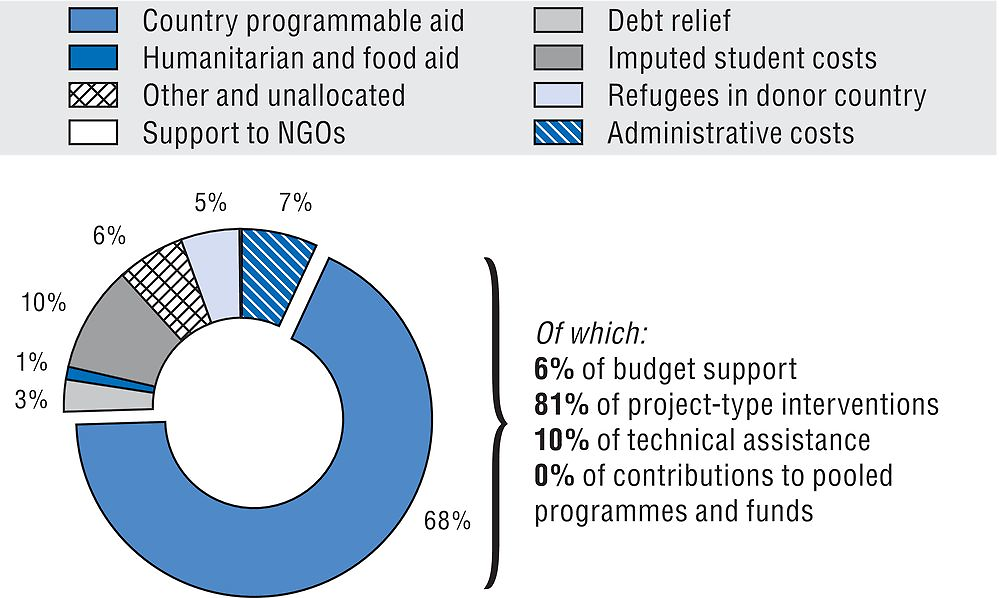
In 2015, USD 198.2 million of bilateral ODA was channelled to and through civil society organisations (CSOs). France’s ODA to and through CSOs decreased between 2014 and 2015 in terms of volume (-13%), and as a share of bilateral aid. This share (2.9% in 2015) was lower than the DAC country average of 16.9%.
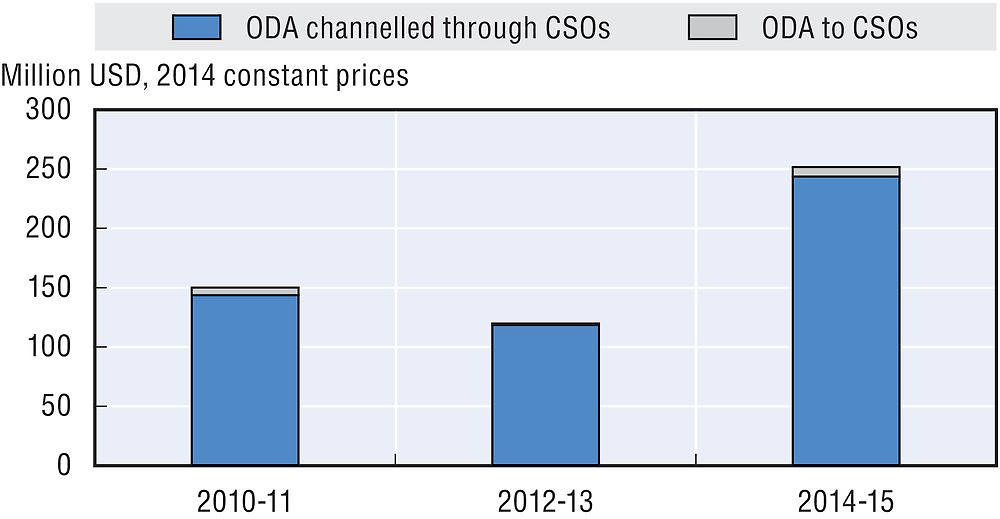
Note: Data on ODA to CSOs are not available for 2012 or 2014.
In 2015, bilateral ODA primarily focused on sub-Saharan Africa, South America and North Africa. In 2015, France allocated USD 2.4 billion to sub-Saharan Africa, USD 954.3 million to South America and USD 748.7 million to North Africa.
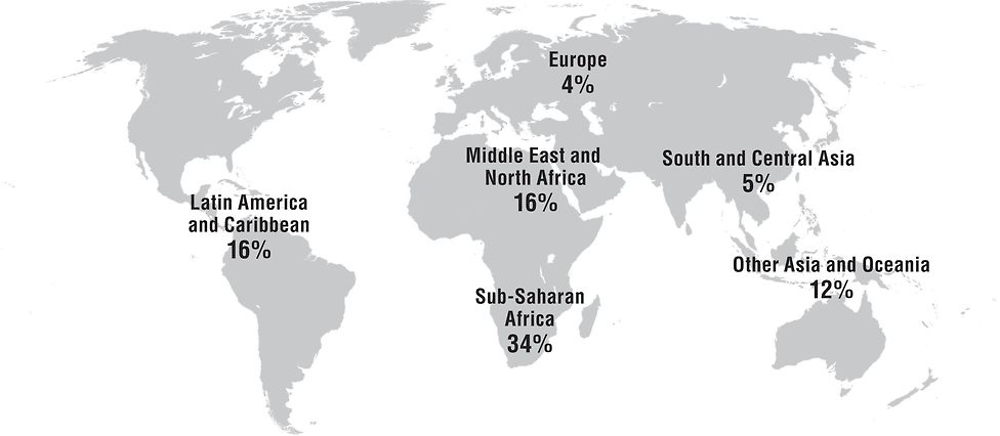
Note: 13% of bilateral ODA allocated was unspecified by region in 2014-15. This share is not represented on the map.
In 2015, 35.5% of bilateral ODA went to France’s top 10 recipients. The French government has decided that at least 50% of France’s grant ODA should go to its 16 priority partner countries, all in sub-Saharan Africa. In 2014-15 just one of these priority countries (Senegal) was on the list of top 10 recipients. France’s support to fragile contexts reached USD 1.9 billion in 2015 (27.7% of gross bilateral ODA).
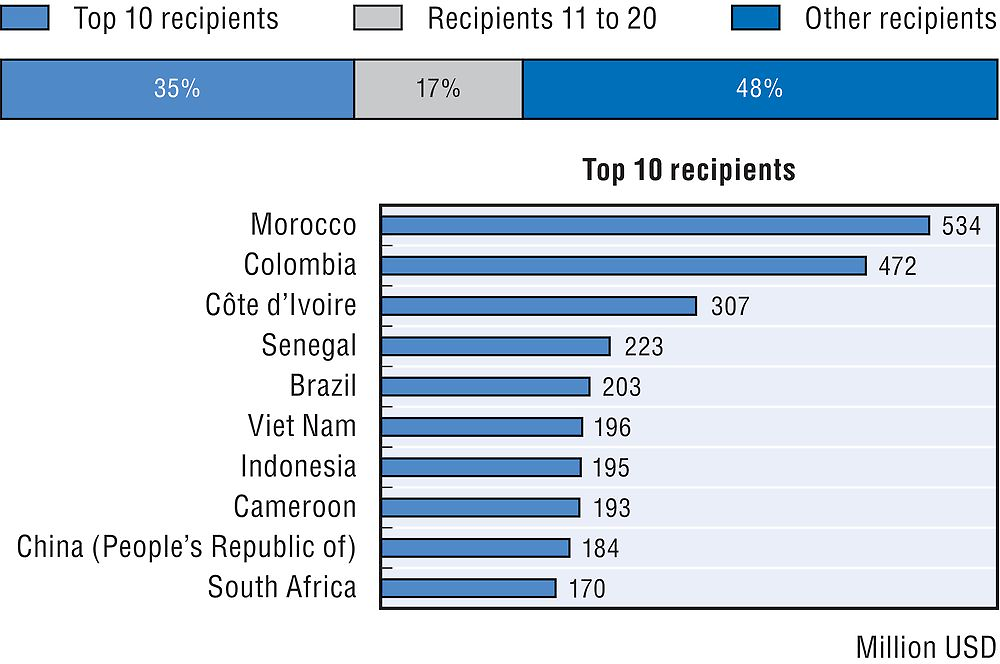
In 2015, 18.8% of gross bilateral ODA was allocated to least developed countries (LDCs), amounting to USD 1.3 billion. This is a slight increase from 2014 (17.7%), and is lower than the 2015 DAC average of 24.3%. Upper middle-income countries received the highest share of bilateral ODA in 2015 (32%).
At 0.10% of GNI in 2015, ODA to LDCs was lower than the UN target of 0.15% of GNI.
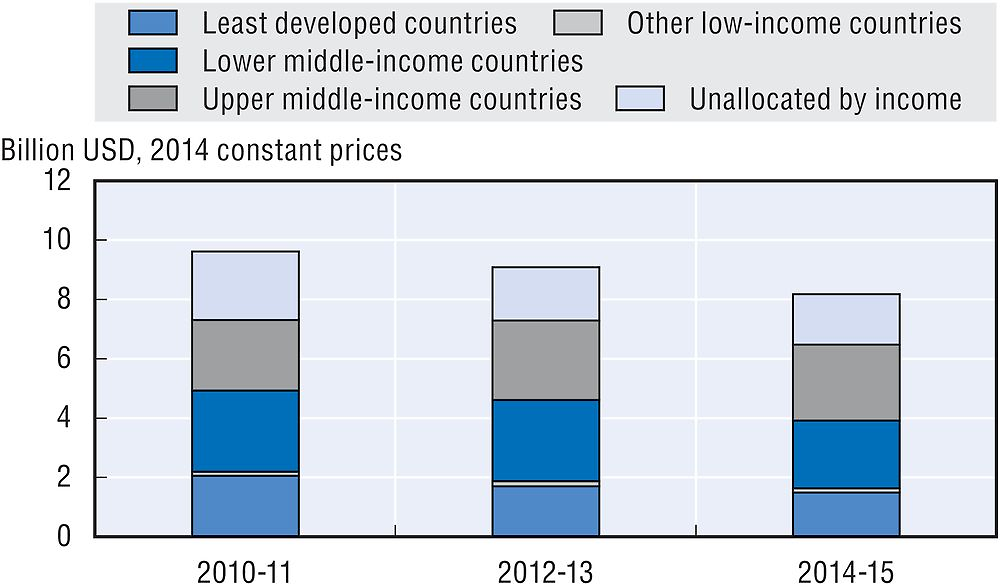
In 2015, 31.1% of France’s bilateral ODA was committed to social infrastructure and services, amounting to USD 2.7 billion, with a strong focus on education (USD 1.2 billion) and water and sanitation (USD 826.8 million). USD 2.2 billion (25.3% of bilateral ODA) was allocated to economic infrastructure and services, mainly to energy generation and supply (USD 1.6 billion) and transport and storage (USD 399.2 million). Humanitarian aid amounted to USD 36 million.

USD 1 billion of bilateral ODA supported gender equality in 2015. France has made positive steps to integrate gender equality into its development co-operation with a new Gender and Development Strategy (2013-17) and the Cross-cutting Intervention Framework, the Agence Française de Développement’s own gender strategy adopted in 2014 (OECD, 2014). In 2015, 17% of French bilateral allocable aid had gender equality and women’s empowerment as a principal or significant objective, compared with the DAC country average of 36.3%. Education, population and reproductive health, and health are the only sectors in which the focus on gender is strong.
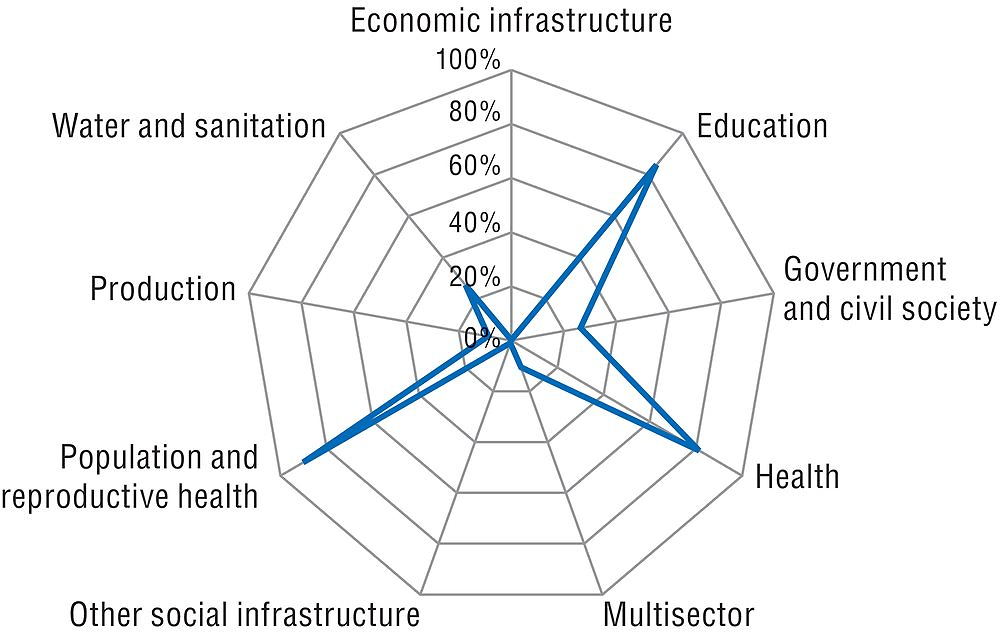
USD 4.2 billion of bilateral ODA supported the environment in 2015. France has taken positive steps to integrate the environment and climate change into its development co-operation (OECD, 2014). This is reflected in its upward funding trend in recent years in bilateral ODA supporting the environment. In 2015, 60.5% of French bilateral allocable aid supported the environment and 48.3% (USD 3.3 billion) focused on climate change, compared with the respective DAC country averages of 33.2% and 26.2%.
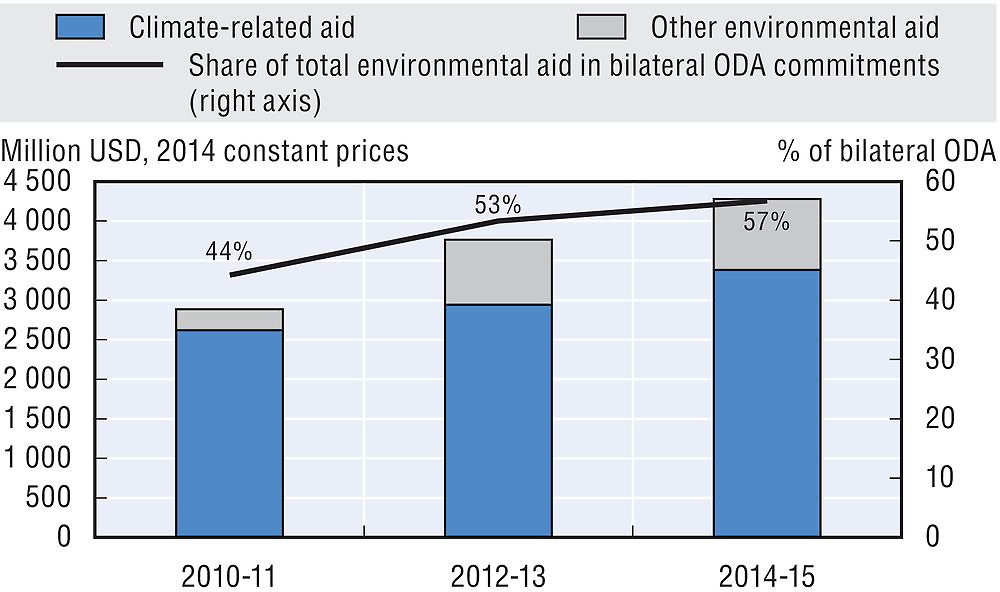
Note to reader: Annex B provides “Methodological notes on the profiles of Development Assistance Committee members”.
Reference
OECD (2014), OECD Development Co-operation Peer Reviews: France 2013, OECD Publishing, Paris, https://doi.org/10.1787/9789264196193-en.
